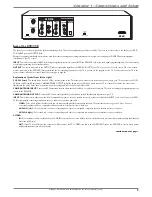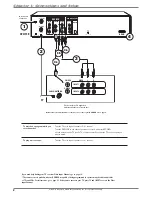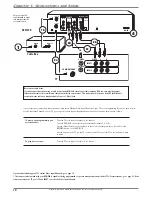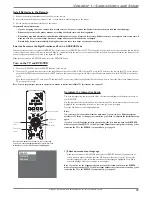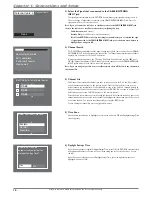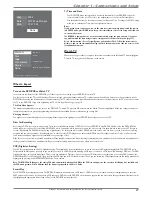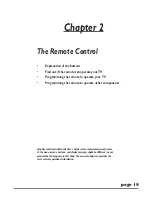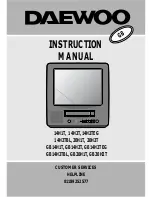
Graphics contained within this publication are for representation only.
4
Chapter 1: Connections and Setup
Explanation of Input Jacks and Cables
This section describes the jacks and cables you can use to make connections (only an S-Video and a set of audio/video cables are packed with your DVD/VCR—you can
purchase other cables by calling 1-800-338-0376, order online at www.rca.com, or go to your local electronics store). There are several ways to connect your DVD/VCR to
your TV depending upon the cables you have and the jacks that are on the back of your TV.
Different jacks and cables provide a different level of performance. It’s important to remember, we’re talking about degrees of picture improvement for comparison. If your TV
has Component jacks (Y, Pb, Pr), S-VIDEO, and composite video (often color-coded yellow and grouped with Audio Left and Right jacks that are white and red); Component
(Y, Pb, Pr), would be considered excellent, S-Video would be very good, and the composite video jack (yellow) would be considered good.
Component Video (Y, Pb, Pr) Jacks and Cables
The Y, Pb, Pr jacks provide optimum picture quality because the video is separated into three signals
(two signals are dedicated to the color portion of the image, and the other signal is dedicated to the
black and white part of the image).
To ensure maximum picture quality, use three video-grade cables (not supplied) for the connection.
You can purchase bundled component video cables (not supplied) that are color-coded to match the
Y, Pb, Pr jacks (red, green, and blue). Component Video Input jacks are usually found on high-end TVs,
such as HDTVs; multimedia monitors; and some of the “fl at” LCD and Plasma TVs or monitors.
Notes:
Also, remember to connect the left and right audio cables because the Y, Pb, Pr jacks and cables
carry only the picture signal, not the sound.
Use the Component Video connection (Y, Pb, Pr) for DVD playback and watching TV. You must
also connect yellow video cable or S-Video for VCR playback in analog mode.
S-Video Jacks and Cables
The S-Video (separate video) jack provides better picture quality than a composite video jack
(sometimes labeled VIDEO and color-coded yellow on TVs) because S-Video keeps the color part
of the picture separate from the black and white part of the picture. If your TV has an S-VIDEO jack,
connect the DVD/VCR to the TV with an S-Video cable for a better quality picture. One S-Video
cable is supplied with your DVD/VCR.
Note: Remember to connect the left and right audio cables because the S-Video cable carries
only the picture signal, not the sound.
Audio/Video Jacks and Cables (RCA-type)
Video
The basic Video jack (usually color-coded yellow) is also referred to as composite video. Composite
video doesn’t keep color information separated (like S-Video), but it’s better than the video quality
you get from an RF coaxial cable (the type used to connect a cable signal or off-air antenna).
Audio
These jacks are used to send the audio from the disc or tape you’re playing in the DVD/VCR to the
TV. The audio jacks and cables (supplied) are often color-coded (red for right audio, and white for
left audio). You must connect audio cables to the AUDIO L and R jacks on the DVD/VCR and the
corresponding Audio Input Jacks on the TV no matter which Video jack you connect (VIDEO;
S-VIDEO; Y, Pb, Pr).
Note: If your TV has only one input for audio (mono), connect it to the left (white L/Mono)
audio jack on the DVD/VCR and don’t connect the right audio part of the cable.
Y
Pb
Pr
S-VIDEO
VIDEO
INPUT
L
R
AUDIO
Содержание DRC8300N
Страница 1: ...Changing Entertainment Again DVD Recorder VCR Combo User s Guide DRC8300N ...
Страница 63: ......







